Filter AUDI A3 2012 Owner´s Manual
[x] Cancel search | Manufacturer: AUDI, Model Year: 2012, Model line: A3, Model: AUDI A3 2012Pages: 280, PDF Size: 70.11 MB
Page 16 of 280
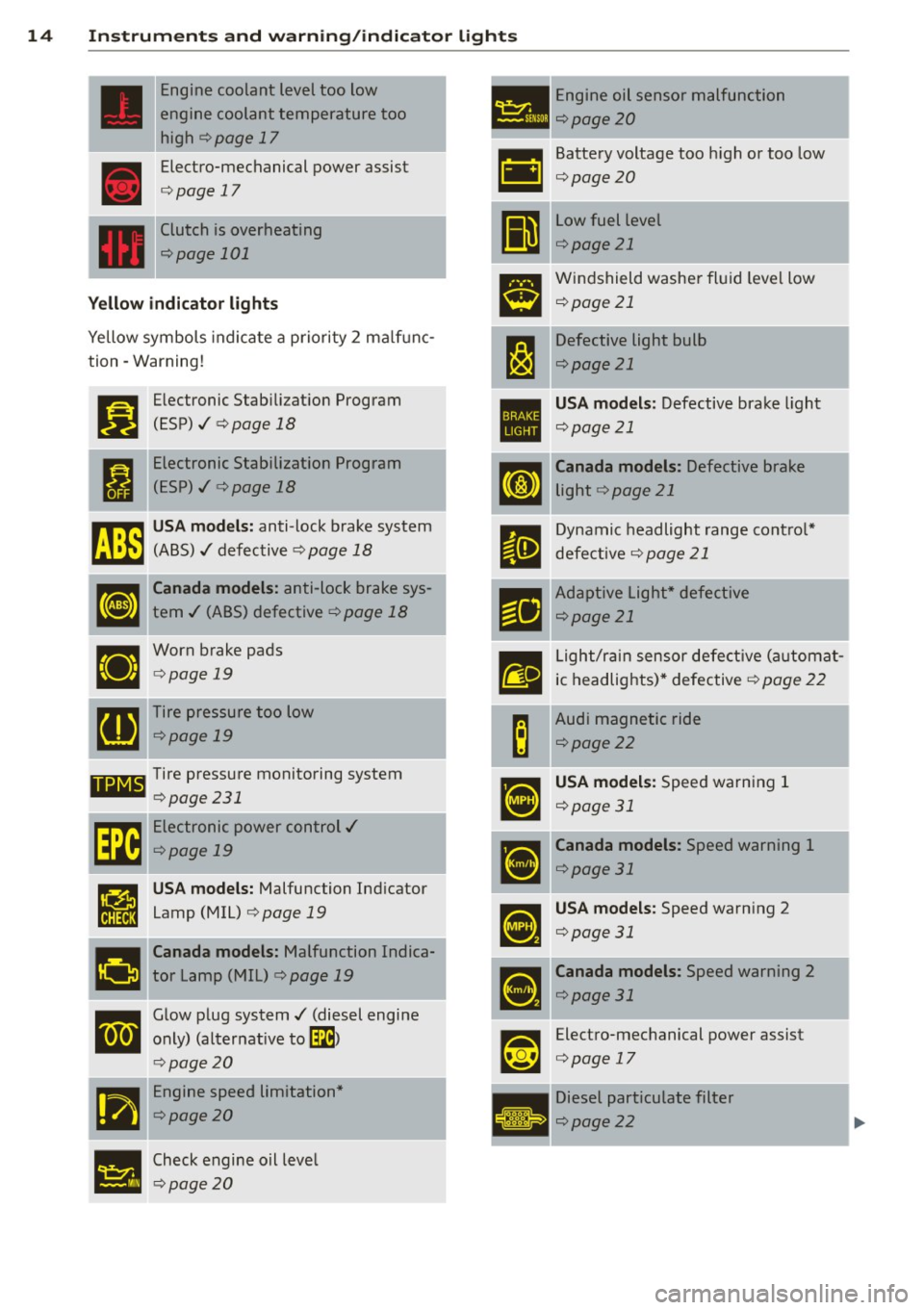
14 Instrum ent s and w arn ing /indic ato r light s
Engine coolant level too low
ii
Engine oil sensor malfunction
engine coolant temperature too
¢page20
high ¢page 17
•
Battery voltage too h igh or too low
Electro-mechanical power assist
¢page20
¢page 17
II
Low fuel level
Clutch is overheating
¢page 21
¢page 101
•
Windshield washe r fl uid level low
Y ellow indicator lights ¢page 21
D
Yellow symbols indicate a priority 2 ma lf u nc-
~:~
Defective light bulb
tion -Warning!
¢page 21
Ji]
Electronic Stab ilizat ion Program
•
U SA mod els : Defective brake light
(ESP)
./¢page 18
¢page 21
I
Electronic Stabilization Program
•
Canada model s: Defective brake
(ESP)./
<=:>page 18 light ¢ page 21
~ USA mod els : anti-lock brake system
II
Dynamic headlight range cont ro l*
(ABS) ./ defective
<=:> page 18 defective ¢ page 21
Canada models: anti-lock brake sys--
[I]
•
Adaptive Light * defective
tern ./ (ABS) defective
¢page 18
¢page 21
•
Worn brake pads
m
Light/rain sensor defective (automat-
¢ page 19 ic headlights) * defective ¢ page 22
g
Tire pressure too low
B
Audi magnetic ride
¢page 19
¢page22
ll@I@ Tire pressure monitoring system
~
USA models: Speed warning 1
¢page 231
¢page 31
[m
Electronic power control./
¢page 19
•
Canada models : Speed warning 1
¢page 31
•
USA models: Malfunction Indicator
Lamp (MIL)
¢page 19
•
USA models: Speed warn ing 2
¢page31
Canada models: Malfunction Indica-
tor Lamp (MIL)
¢page 19
•
Canada models: Speed warning 2
¢page 31
II
Glow plug system ./ (diesel engine
Electro-mechanical power assist
only) (alternative to~ )
M ¢page 17
¢page20
.,
Engine speed limitation *
Diesel particulate filter
¢page20
¢page22
Ill
Check engine oil level
¢page20
Page 24 of 280
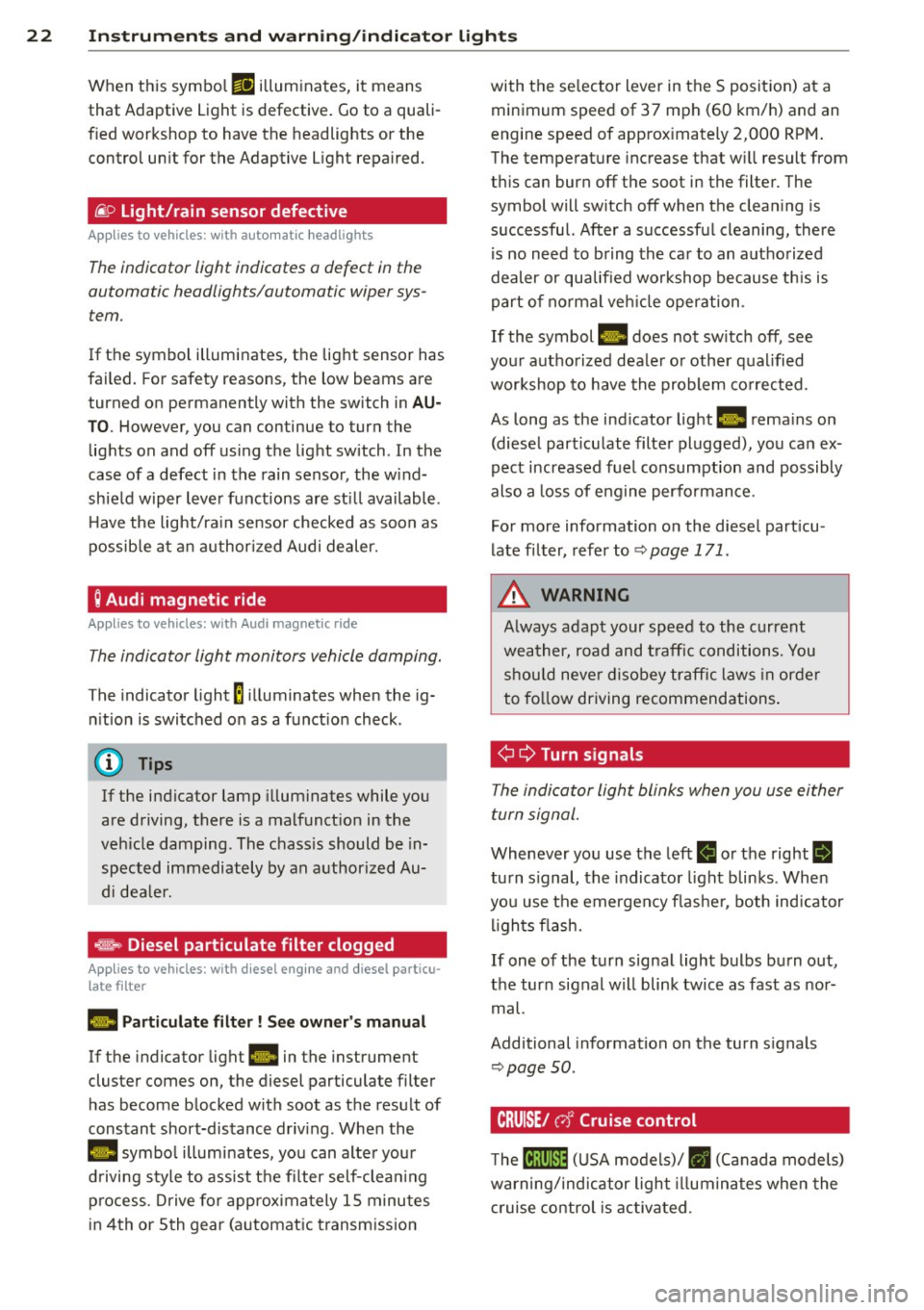
22 Instruments and warning /indicator lights
When this symbo l ml illuminates, it means
that Adaptive Light is defective. Go to a quali
fied workshop to have the headlights or the
control unit for the Adaptive L ight repaired.
@, o Light/rain sensor defective
App lies to vehicles: with automat ic headlights
The indicator light indicates a defect in the
automatic headlights/automatic wiper sys
tem .
If the symbo l illuminates, the light sensor has
failed. For safety reasons , the low beams are
turned on permanently with the switch in
AU
TO . However, you can continue to turn the
lights on and off using the light switch . In the
case of a defect in the rain sensor , the w ind
sh ield wiper lever functions are st ill available .
H ave the light/ra in sensor checked as soon as
possible at an authorized Audi dealer.
; Audi magnetic ride
Appl ies to vehicles: with Audi magnetic ride
The indicator light monitors vehicle damping.
The indicator light E illuminates when the ig
nition is switched on as a function check.
@ Tips
If the indicator lamp illuminates while you
are driving, there is a malfunct ion in the
veh icle damping. The chass is should be in
spected immediately by an authorized Au
di dealer.
~ Diesel particulate filter clogged
Applies to vehicles: with diesel engine and diesel particu
late fi lter
1/1 Particulate filter ! See owner's manual
If the indicator light II in the instrument
cluster comes on, the diesel particulate filter has become blocked with soot as the result of
constant short-distance driving. When the
II symbol illuminates, you can alter your
driving style to assist the filter self-clean ing
p rocess. Drive for approximately 15 minutes
in 4th or 5th gear (automatic transmission with the se
lector lever in the S position) at a
minimum speed of 37 mph (60 km/h) and an
engine speed of approx imately 2,000 RPM .
The temperature increase that will result from
this can burn off the soot in the filter. The
symbol will switch off when the cleaning is
successful. After a successful cleaning, there
is no need to bring the car to an authorized
dealer or qualified workshop because this is
part of normal vehicle operation .
If the symbol
DI does not switch off, see
your autho rized dea ler or other qualified
workshop to have the problem corrected .
As long as the indicator light
11!1 remains on
(diesel part iculate filte r plugged), you ca n ex
pect increased fuel consumption and possibly
also a loss of engine performance.
For more information on the diesel particu
late filter, refer to~
page 171 .
A WARNING ,__
Always adapt your speed to the current
weather, road and traffic conditions. You
should never disobey traffic laws in order
to follow driving recommendations .
¢ ¢Turn signals
-
The indicator light blinks when you use either
turn signal.
Whenever you use the left B or the right fl
turn s ignal, the indicato r light blinks . When
you use the emergency f lasher, both indicator
lights flash.
If one of the turn signal light bulbs burn out,
the turn signal will blink twice as fast as nor
mal.
Additional information on the turn s ignals
Q page SO.
CRUISE/ vf Cruise control
T he
(ijjll j~i~ (USA models)/. (Canada models)
warning/indicator light illuminates when the
cruise control is activated .
Page 81 of 280
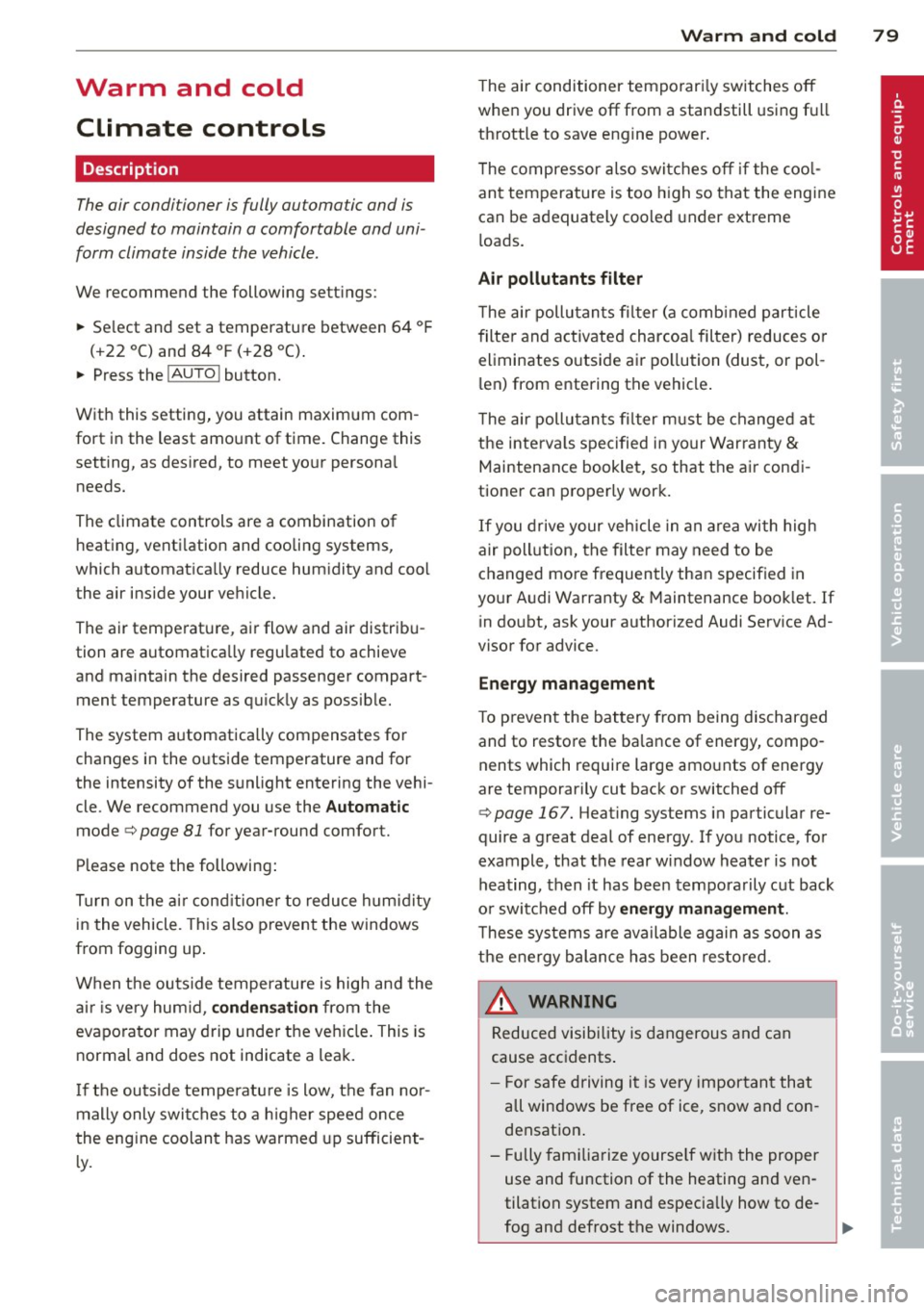
Warm and cold Climate controls
Description
The air conditioner is fully automatic and is
designed to maintain a comfortable and uni
form climate inside the vehicle .
We recommend the following settings:
... Se lect and set a temperature between 64 °F
(+ 22 °C) and 84 °F (+28 °C).
... Press the
!AU TO ! button.
With this setting, you attain maximum com
fort in the least amount of time. Change this
setting, as desired, to meet your personal
needs.
The climate controls are a combination of
heating, ventilation and cooling systems,
which automatically reduce humidity and cool the air inside your vehicle.
The air temperature, air flow and air distribu
tion are automatica lly regulated to achieve
and maintain the desired passenger compart
ment temperature as quickly as possib le.
The system automatically compensates for
changes in the outside temperature and for
the intensity of the sunlight entering the vehi
cle. We recommend you use the
Automatic
mode c> page 81 for year-round comfort.
Please note the following:
Turn on the air conditioner to reduce humidity
in the vehicle. This also p revent the windows
from fogging up .
When the outside temperature is high and the
air is very hum id,
condensation from the
evaporator may drip under the vehicle . This is
normal and does not indicate a leak.
If the outside temperature is low, the fan nor
mally only switches to a h igher speed once
the engine coolant has warmed up sufficient
ly.
Warm and cold 79
T he air conditioner temporari ly switches off
when you drive off from a standstill using full
throttle to save engine power.
T he compressor also switches off if the cool
ant temperature is too high so that the engine
can be adequately cooled under extreme
l oads.
Air pollutants filter
T he air pollutants filter (a combined particle
filter and activated charcoa l filter) reduces or
eliminates outside air pollution (dust, or pol
l en) from entering the vehicle .
T he air pollutants filter must be changed at
the interva ls specified in yo ur Warranty
&
Maintenance booklet, so that the air condi
tioner can properly work.
If you drive your vehicle in an area with high
air pollution, the filter may need to be
changed more frequently than specified in
your Audi Warranty
& Maintenance booklet. If
in doubt, ask your authorized Audi Service Ad
visor for advice.
Energy management
To prevent the battery from being discharged
and to restore the ba lance of energy, compo
nents which require large amounts of energy
are temporarily cut back or switched off c> page 167. Heating systems in particular re
quire a great deal of energy. If you notice, for
example, that the rear window heater is not
heating, then it has been temporarily cut back
o r switched off by
energy management.
These systems are available again as soon as
the energy balance has been restored.
_& WARNING
.-----
Reduced visibility is dangerous and can
cause accidents .
- For safe driving it is very important that
all windows be free of ice, snow and con-
densation.
- Fully familiarize yourself with the proper
use and function of the heating and ven
tilation system and especia lly how to de
fog and defrost the windows.
Page 173 of 280

-Have your vehicle maintained properly
and in accordance with the service rec
ommendations in your Warranty
&
Maintenance booklet.
- Lack of proper maintenance as well as
improper use of the vehicle will impair
the function of the emission control
system and could lead to damage.
@ For the sake of the environment
Even when the Emission Control System is
operating properly, the exhaust gas can
have a sulfur-like exhaust gas smell under
some operating states. This depends on
the sulfur content of the fuel being used .
Using a different brand of fuel may help,
or filling the tank w ith lead-free super
grade gasoline.
Diesel particulate filter
Ap plies to vehicles: with diesel partic ul ate filter
The diesel particulate filter filters nearly al l of
the soot part icles out of the exhaust. The fi l
ter cleans itse lf automatically under normal
driving conditions . If the fi lter cannot clean it
self (for example, because you are only driving
short distances), the filter becomes clogged
with soot and the
II symbol for the diesel
particulate filter illuminates
c> page 22.
A WARNING
- Do not park your vehicle over flammable
materials such as grass or leaves because
the high temperature of the diesel par
t icu late filter could start a fire .
- Do not apply an underbody protectant in
the exhaust system a rea or a fire could
start.
(D Tip s
-When the diesel particulate filter be
comes saturated, the engine speed in
creases to approximate ly 1,500 rpm
while the vehicle is in motion to init iate
the cleaning of the diesel particulate fil
ter a utomatically without the warning
l amp lighting up . If the warning lamp
Dri vin g and en vironm ent 171
Ill sti ll appears, you shou ld drive to a
qualified workshop .
Avoid damaging the
vehicle
When you are driving on poor roads, or over
curbs, steep ramps, etc., make certain that
low -lying parts such as spo ilers and exhaust
system parts do not bottom out and get dam
aged.
This is espec ially true for veh icles with low
slung chassis (sports chassis) and fully loaded
vehicles.
Operate your vehicle
economically and minimize pollution
General
Your personal style of driving will determine
the economy of your vehicle, as well as ex
haust and noise Levels.
Fuel economy, env ironmenta l impact, and
wear on your eng ine, brakes and tires largely
depend on three facto rs:
- your personal driving style
- operating conditions
- technical limitations
If you ant ic ipate wha t you need to do next and
drive economically, you can easily cut your
fuel consumptio n by 10-15 percent . This sec
tion wi ll give you some tips on how you can
help the env ironment and your pocketbook.
(D Tips
The consumption estimates as published
by ENVIRONMENTAL PROTECTION AGENCY
(EPA) and Transport Canada may not corre
spond to your actual consumption on the road, which will vary depending upon vehi
cle load and speed, road and weather con
dit ions, trip length, etc.
•
•
Page 181 of 280

CD Note
You should remove debris (such as insects)
from the headlight lenses on a regular basis, for example when refueling your vehi
cle. Never clean the headlights with a dry
cloth or sponge . Use a wet cloth or
sponge.
It is best to use soapy water .
Automatic car wash
The vehicle can be washed in almos t any
modern automatic car wash .
The vehicle paint is so durable that the vehicle
can normally be washed without problems in
an automatic car wash . However, the effect on
the paint depends to a large extent on the de
sign of the facility, the filtering of the wash
water , the type of wash and care material , etc .
If the paint has a dull appearance after going
through the car wash or is scratched, bring
this to the attention of the operator immedi
ately. If necessary, use a different car wash.
Before going through a car wash, be sure to
take the usual precautions such as closing the
windows and panoramic sliding sunroof*. Re move antenna if applicable.
If you have installed additional accessories on
the vehicle -such as spoilers, roof rack, etc. -
it is best to ask the car wash operator if these
should be removed.
A WARNING
Always read and heed all WARNINGS and other information
¢ page 178.
Washing the vehicle by hand
A lot of water is needed when washing a vehi
cle by hand.
11-Before you start washing, make sure you
have read and understood the WARNINGS
¢ A in General information on page 178.
11-First soak all dried dirt until it is soft, then
rinse it off .
11-As you clean your vehicle, s tart with the
roof and work your way down to the bottom,
Cleaning and protection 179
using a sponge, a sponge glove or a clean
brush.
"" Rinse the sponge or the sponge glove often,
flushing it clean each time.
11-Use special car shampoo only for very per
sistent dirt .
11-Rinse the car thoroughly with water .
11-Use a chamois leather to gently wipe the ex-
terior dry.
Use a separate sponge for cleaning the
wheels, door sills and other regions exposed
to road dirt. In this way, you will not scratch
the paint with coarse particles imbedded in
the sponge the next time you wash the car.
A WARNING
= -
-Do not clean the underside of the chas-
sis, fenders, wheel covers , or other hard
to reach parts without protecting your hands and arms . You may cut yourself on
sharp-edged metal parts.
- Always read and heed all WARNINGS and
other information
¢ page 178.
CD Note
- Never try to remove dirt, mud or dust if
the surface of the vehicle is dry. Never
use a dry cloth or sponge, since this
could scratch your vehicle's paint or win
dows.
- Never wash your car in bright sunlight.
Drops of water act as magnifying lenses
and may damage your paint .
- When you wash your car in the winter: if
you rinse your vehicle with a hose, be
careful not to aim the stream of water
directly at locks, or at door or hatch
openings -they can freeze shut.
- Never use sponges designed to remove
insects, or any kitchen scouring sponges
or similar products. They can damage
your paint finish.
- Never use a dry cloth or sponge to clean
the headlights. Only use wet cloths or
sponges to prevent scratches. It is best
to use soapy water. •
•
Page 193 of 280
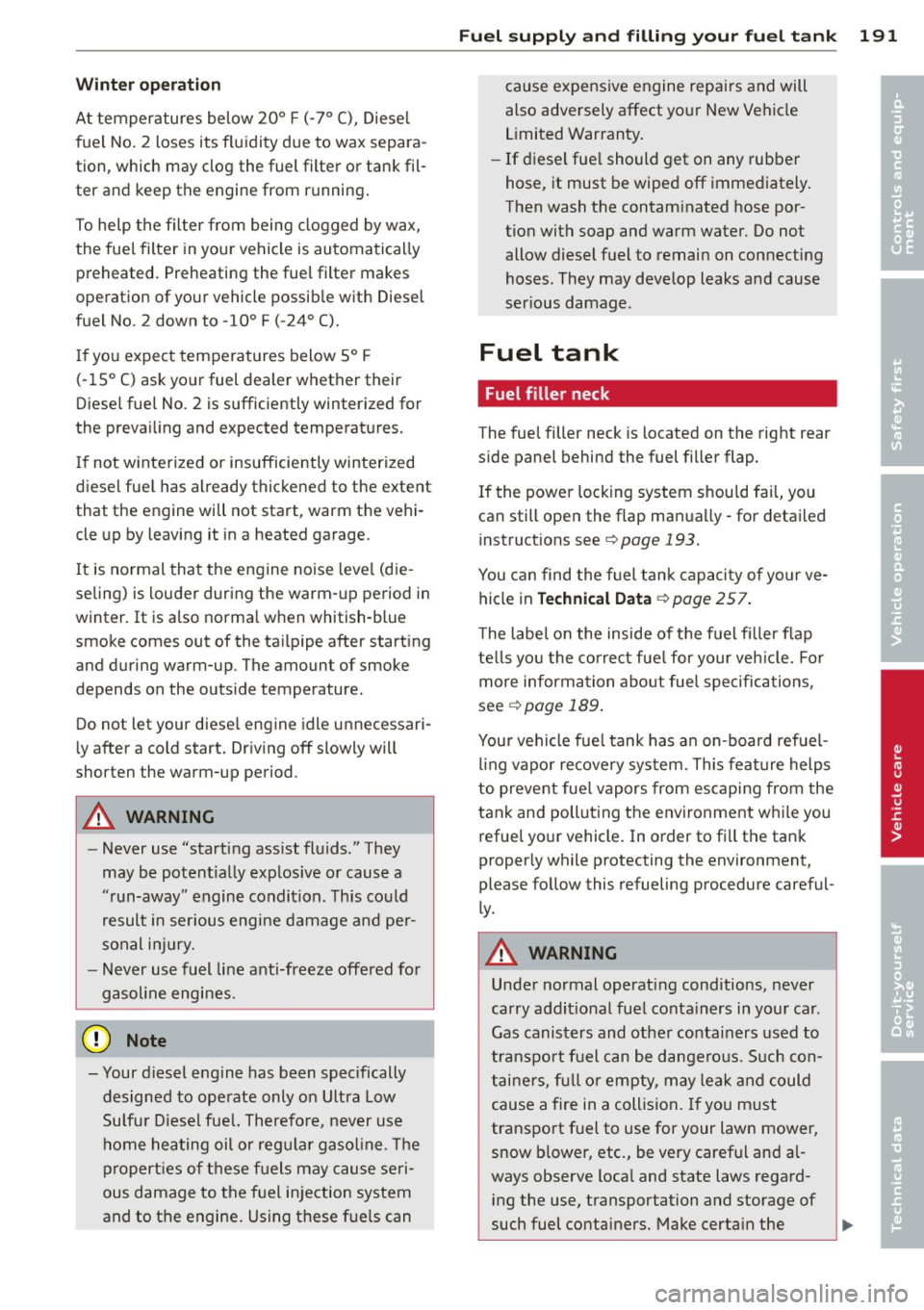
Winter operation
At temperatures below 20° F (-7° C), Diesel
fuel No.
2 loses its fluidity due to wax separa
tion, which may clog the fuel filter or tank fil
ter and keep the engine from running .
To help the filter from being clogged by wax,
the fuel filter in your vehicle is automatically
preheated. Preheating the fuel filter makes
operation of your vehicle possible with Diesel
fuel No . 2 down to -10° F (-24° C).
If you expect temperatures below
5° F
(-15° C)
ask your fuel dealer whether their
Diese l fuel No.
2 is sufficiently winterized for
the prevailing and expected temperatures.
If not winterized or insufficiently winterized
d iesel fue l has already thickened to the extent
that the engine will not start, warm the vehi
cle up by leaving it in a heated garage.
It is normal that the engine noise leve l (die
seling) is louder during the warm-up period in
winter.
It is also norma l when whitish-blue
smoke comes out of the tailpipe after start ing
and during warm-up . The amount of smoke
depends on the outs ide temperature.
Do not let your diesel engine idle unnecessari
ly after a cold start. Driving off slowly will
shorten the warm-up period .
A WARNING
-Never use "starting assist fluids." They
may be potent ially explosive or cause a
"run-away" engine condition. This could
result in serious engine damage and per
sonal injury.
- Never use fuel line anti-freeze offered for
gasoline engines .
0 Note
- Your diesel engine has been specifically
designed to operate only on Ultra Low
Sulfur Diesel fuel. Therefore, never use
home heating oil or regular gasol ine. Th e
properties of these fuels may cause seri
ous damage to the fuel injection system
and to the engine. Using these fuels can
-
Fuel supply and filling your fuel tank 191
cause expensive engine repai rs and will
also adversely affect your New Vehicle
Limited Warranty.
- If diesel fuel should get on any rubber
hose, it must be wiped off immediately.
Then wash the contaminated hose por
tion with soap and warm water. Do not
allow diesel fuel to remain on connecting
hoses. They may develop leaks and cause
ser ious damage.
Fuel tank
Fuel filler neck
The fuel filler neck is located on the right rear
side panel behind the fuel filler flap.
If the power locking system should fail, you
can still open the flap manually -for detailed
instructions see
¢ page 193.
You can find the fuel tank capacity of your ve
hicle in
Technical Data ¢page 257 .
The labe l on the inside of the fuel fi ller flap
tells you the correct fuel for your vehicle. For
more information about fuel specifications,
see
¢ page 189.
Your vehicle fuel tank has an on-board refuel
ling vapor recovery system. This feature helps
to prevent fuel vapors from escaping from the
tank and polluting the environment while you refue l your vehicle. In order to fi ll the tank
properly while protecting the environment,
please follow this refueling procedure careful
ly.
A WARNING
Under normal operating conditions, never
carry addit ional fuel conta iners in your car .
Gas canisters and other containers used to
transport fuel can be dangerous. Such con
tainers, full or empty, may leak and could
cause a fire in a collision. If you must
transport fuel to use for your lawn mower,
snow b lower, etc., be very careful and al
ways observe loca l and state laws regard
ing the use, transportation and storage of
such fuel containers. Make certain the
~
•
•
Page 201 of 280
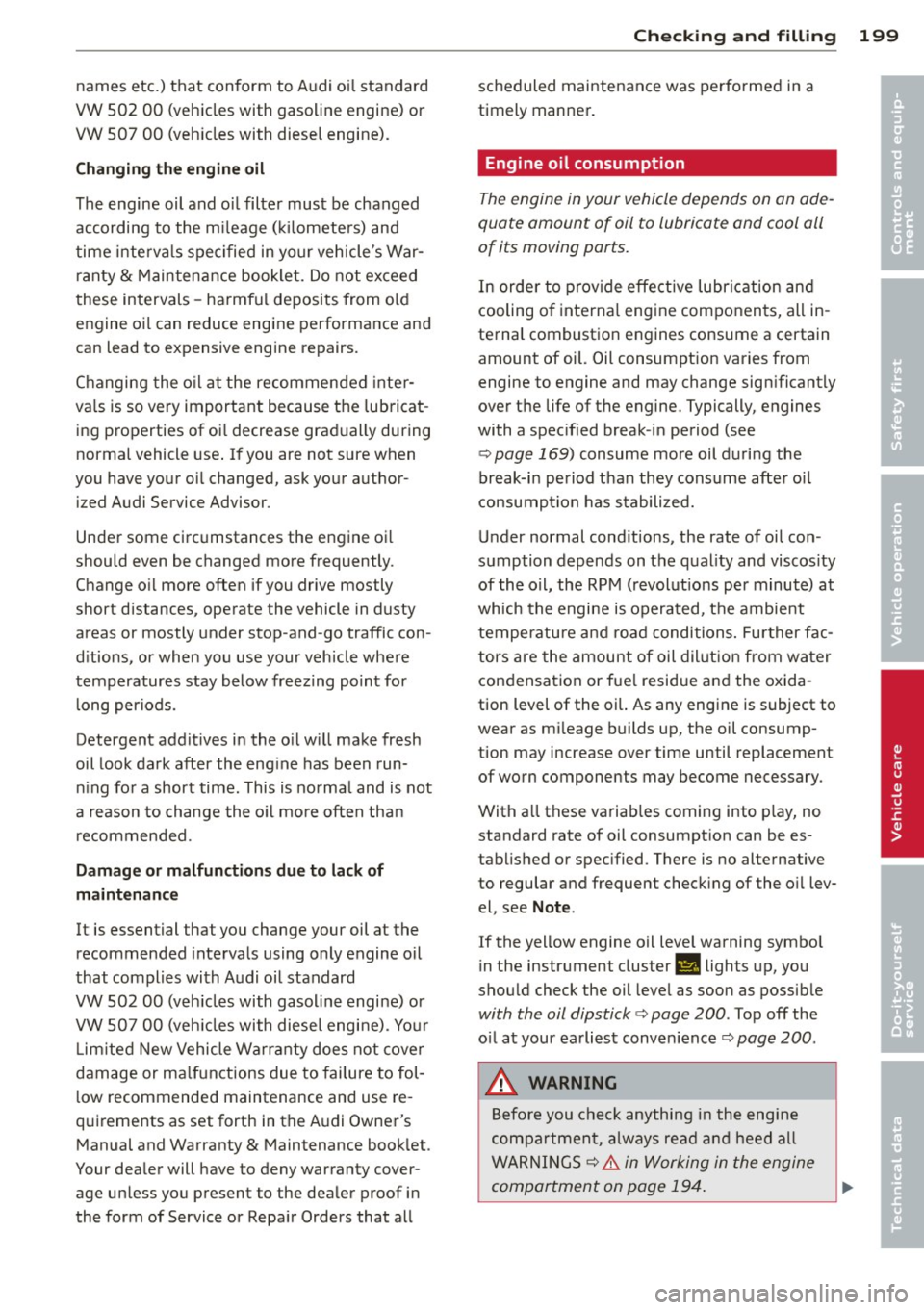
names etc.) that conform to Audi oil standard
VW 502 00 (vehicles with gasoline engine) or
VW 507 00 (vehicles with diesel engine).
C hang ing th e engin e oil
The engine oil and oi l filter must be changed
according to the m ileage (kilomete rs) and
time inte rva ls specified in yo ur vehicle's War
ranty
& Maintenance booklet. Do not exceed
these intervals -harmful deposits from old
engine oil can reduce engine performance and
can lead to expensive eng ine repairs.
Changing the o il at the recommended inter
va ls is so very important because the lubricat
ing properties of oi l decrease gradually during
norma l vehicle use . If you are not sure when
you have your oi l changed, ask your author
ized Audi Service Advisor.
Under some circumstances the engine oi l
should even be changed more frequently.
Change o il more often if you drive mostly
short distances, operate the vehicle in dusty
areas or mostly under stop-and-go traffic con
d itions, or when you use your veh icle where
temperatures stay below freezing point for
l ong periods.
Detergent addit ives in the o il w ill make fresh
oil look dark after the eng ine has been run
n ing for a short time. This is norma l and is not
a reason to change the o il mo re often than
r ecommended.
D amage or ma lf u nction s du e to lac k of
ma int enance
It is essential that you change your oil at the
recommended interva ls using only engine oil
that complies with Audi oil standard
VW 502 00 (veh icles with gasolin e engine) or
VW 507 00 (veh icles with diese l engi ne). Yo ur
L im ited New Vehicle Warra nty does not cover
damage or ma lfunctions due to failure to fol
l ow recommended maintenance and use re
quirements as set forth in the A udi Owner's
Manual and Warranty
& Maintenance book let.
Your dealer will have to deny warranty cover age un less you present to the dea ler proof in
the form of Service or Repa ir Orders that a ll
Checking and fillin g 199
scheduled maintenance was performed in a
timely manner.
· Engine oil consumption
The engine in your vehicle depends on an ade
quate amount of oil to lubricate and cool all
of its moving parts.
In order to prov ide effective lubrication and
cooling o f inte rna l engine components, all in
ternal combustion engines consume a certain amount of oil. Oil consumpt ion varies from
engine to engine and may change sign ificantly
over the life of the engine. Typically, engines
with a spec ified break-in period (see
Q page 169) consume more oil during the
break-in pe riod than they consume after o il
consump tion has stabilized.
Under normal cond itions, the rate of oi l con
sumption depends on the quality and viscos ity
of the oil, the RPM (revolut ions per minute) at
which the engine is operated, the ambient
temperature a nd road conditions. Further fac
tors are the amount of oil dilut ion from wa ter
condensation or fue l residue and the oxida
tion level of the oi l. As any engine is subject to
wear as mi leage builds up, the oil consump
tion may increase over time until replacement
of worn components may become necessary.
With a ll these variab les coming into p lay, no
standard rate of oil consumption can be es
tablished or spec ified. There is no alternative
to regular and frequent check ing of the oil lev
el, see
Not e.
If the yellow engine oil level warning symbo l
in the instrument cluster
Ill! lights up, you
shou ld check the oil leve l as soon as possib le
with the oil dipstick q page 200 . Top off the
o il at your earliest conven ience
Q page 200.
&_ WARNING
Before you chec k anything in the engine
compartment, always read and heed al l
WARNI NGS
Q .&. in Working in the engine
compartment on page 194 .
•
•
Page 259 of 280
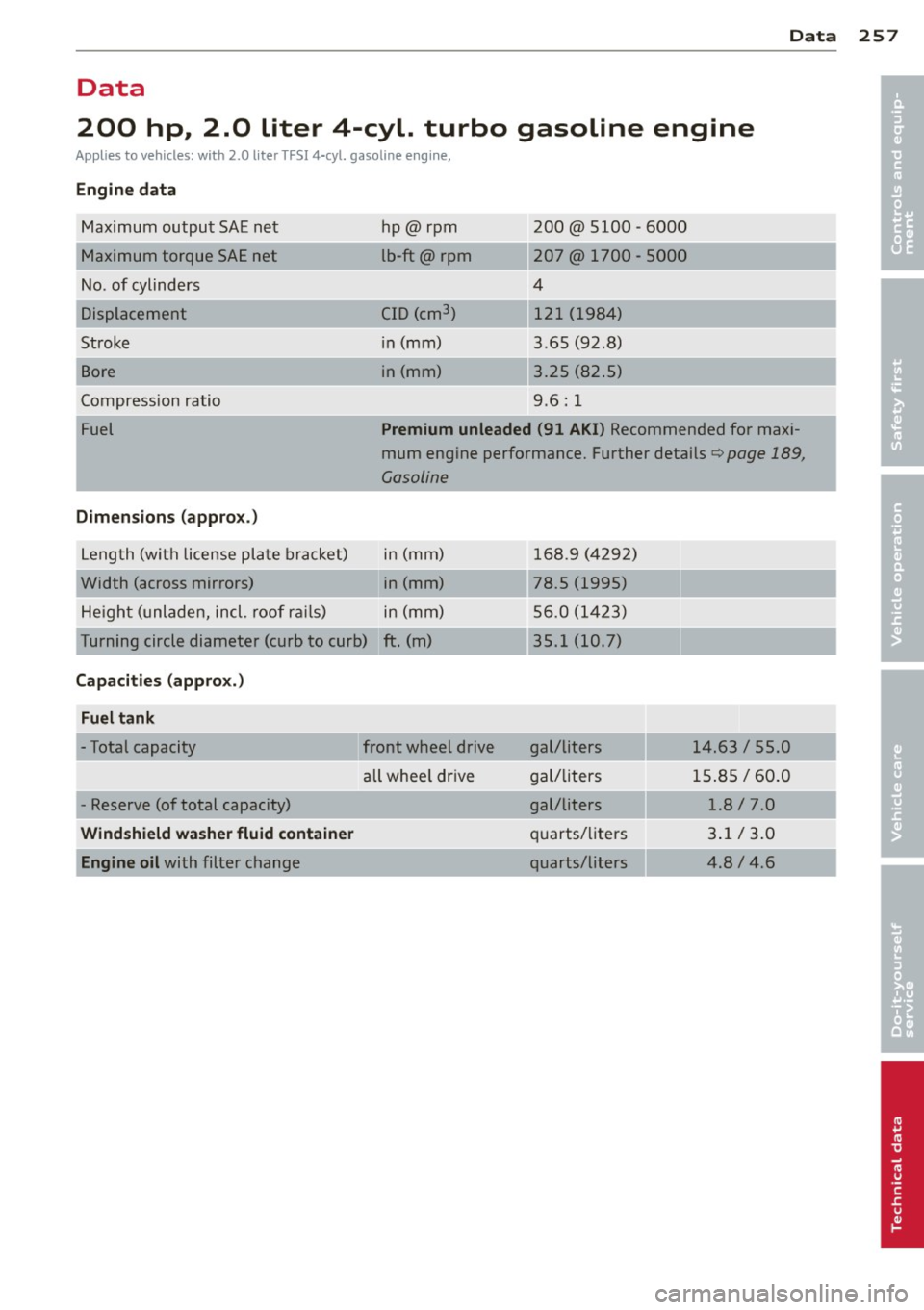
Data 257
Data
200 hp, 2.0 liter 4-cyl. turbo gasoline engine
Applies to vehicles: with 2.0 liter TFS! 4-cyl. gasoline engine,
Engine data Maximum outpu t SAE ne t
M aximum torque SAE net
No . of cylinders
Displacement
Stroke
Bore
C ompression ratio
Fuel
Dimensions (approx .)
L eng th (wit h license pl ate brac ket)
Width (across mirrors) He igh t (unladen, incl . roof r ails) 200@ 5100
-6000
hp@r pm
lb-ft@ rp m
-~--
CID (cm3
)
in (mm)
in (mm)
---·
207 @ 1700 - 5000
4
121 (1984)
3 .65 (92 .8)
3.25 (82 .5)
9 .6: 1
Premium unleaded
(91 AKI) Recommended for maxi
mum engine performance. Further details ¢page 189,
Gasoline
in (mm) 168.9 (42 92)
in (mm) 78.5 (1995)
in (mm) 56.0 (1423)
T urning circle diameter (curb to curb) ft. (m) 35.1 (10.7)
Capacities (approx.)
Fuel tank
- Total capacity
- Reserve (of total capacity)
Windshield washer fluid container Engine oil with filter change front wheel
drive
a ll whee l drive gal/liters
14.63 / 55.0
g al/liters 15.8 5 / 60 .0
gal/liters 1.8/7.0
qu arts/ liters 3 .1 / 3 .0
quarts/li ters 4.8 / 4.6
•
•
Page 260 of 280
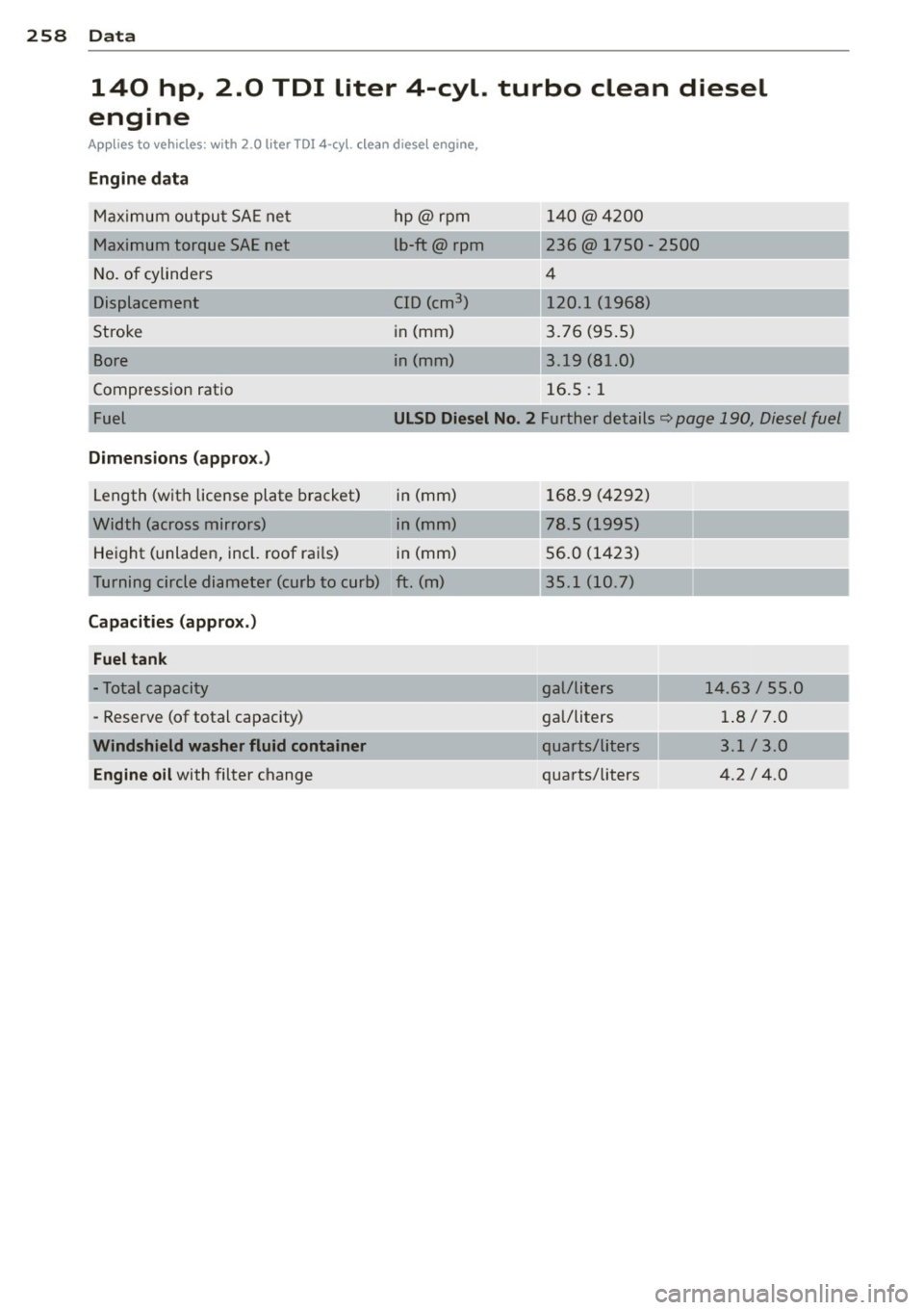
258 Data
140 hp, 2.0 TOI liter 4-cyl. turbo clean diesel
engine
App lies to vehicles: with 2.0 liter TD! 4-cyl. clea n diesel engine,
Engine dat a
Maximum ou tpu t SA E ne t hp@rpm 140 @42 00
Maximum torque SAE net lb-ft@ rpm 236@ 1750 -2500
N o. of cylinders 4
Displacement CID (cm3
) 120.1 ( 1968)
Stroke i
n (mm) 3.7 6 (9 5.5)
Bore i
n (mm) 3.19 (8 1.0)
Compression ratio 16.5: 1
Fuel ULSD Diesel No . 2 Further details c::> page 190, Diesel fuel
Dimensions (approx .)
Length (with license plate bracket) in (mm)
Width (across mirrors) in (mm)
Height (unladen, incl. roof ra ils) in (mm)
T urning circl e diameter (curb to curb) ft. (m)
Capacities (approx.)
Fuel tank
- Total capacity
- Reserve (of total capacity)
Windshield washer fluid container
Engine oil
with filter change
168.9 (4 292)
78.5 (1995)
56 .0 (1423)
35.1 (1 0.7)
gal/li te rs 1 4 .63 / 55.0
ga I/liters 1.8/7 .0
quarts/liters 3.1 / 3.0
quarts/liters 4 .2 I 4.0
Page 269 of 280

Index 267
-----------------------------------.......
Cruise control ... ... .... ... .. .. .. .... 94
Changing speed ... .... ... .. .. .. .... 94
Presetting your speed .... ... .. .. .. .. 95
Sw itching off ... .. .... ... .... .. .. .. 95
Sw it ching on .... ......... .... .. .. .. 94
Warn ing/ indicator lights ........ .... . 22
Cup holder ... .. .... .... ... .. .. .. .... 74
Cup holders fro nt .. .. .. .. .. ........... .. .. .. .. 74
Current fuel mileage . . . . . . . . . . . . . . . . . 26
D
Damping
refer to Audi magnetic ride . .. .. .. .. .. 95
D ata . ... .. .. .. .... .. .... ... .. .. ... 257
Data recorder .. .... .. ... .. .. .. .. .. . 161
Date display . . . . . . . . . . . . . . . . . . . . . . . . 11
D aytime r unning lights ...... .. .. .. .. .. 47
Daytime running lights (Canada) .. .. .. .. 47
D eclaration of compliance
Cell phone package .... ... .. .. .. .. . 262
E lectronic immobili zer ..... .. .. .. .. . 262
HomeLink ® univer sal remo te control . . 262
Remote control key ..... .. .. .. .. .. . 262
Tire pressure monitor ing system .... . 262
def What does this mean when it appears in
the trip odometer d isplay? . .. .. .. .. .. 12
D efective light bulb warning . . . . . . . . . . . 21
Defogging the windows . . . . . . . . . . . . . . . 82
Defrosting/defogging w indows ....... .. 84
D efrosting the w indow s ..... .. .. .. .. .. 8 2
Determin ing cor rect load limit . .. .. .. . 221
D iese l engine
Adding engine oil . ..... ... .. .. .. .. . 202
Changing engine o il ....... .. .. .. .. . 202
Eng ine oil .. ............. .... .. .. . 202
D iese l fue l ... .. ... ..... ... .. .. .. ... 190
Diesel particu late filter . . . . . . . . . . 22, 17 1
Dig ita l clock ... .... .... ... .. .. .. .... 11
Sett ing the time .......... .. .. .. .. .. 11
Di git al compass ........... .. .. .. .. .. 59
Dimensions .................. .... .. 256
Dimming the rearview mirro r . . . . . . . . . . 54
Di pstick
Reading the d ipstick p roperly . .. .. .. . 200 D
irec t Shift Gearbox
Emergency re lease . .. ... .... ... .. .. 102
Distance ... .. .. .. ................. . 26
Doors, power locks . . . . . . . . . . . . . . . . . . . 38
Driver in format ion sys tem
Engine o il temperature display ... .. .. . 31
Gearshift indicator . .. ... .... ... .. .. . 24
Menu button . . . . . . . . . . . . . . . . . . . . . . 28
Open door or front lid warn ing ... .. .. . 23
Outs ide temperature disp lay . . . . . . . . . . 23
Red symbols ..... .. ..... ........... 13
Se rv ice interval display . . . . . . . . . . . . . . 30
Setting ... .. .. .. .. .. ........... .. . 28
Sound sys tem disp lay . ......... .. .. . 23
T rip comp uter .. .. ................. . 25
yellow symbo ls . . . . . . . . . . . . . . . . . . . . . 14
Driver Information System Menu disp lay .. .. .. . ... ...... ... .. . 27
Driver seat
refer to Seating position .......... .. 104
Driving safely ... .... . ... ...... ... .. 103
Drivi ng throug h wate r .............. . 170
D uplicate key . .. .. .... ............. . 34
E
Efficiency program ... . .. .. ... ... .. .. . 29
Fuel economy m essages ..... ... .. .. . 29
Other equipment . ................. . 29
E lapsed time . . . . . . . . . . . . . . . . . . . . . . . . 26
E lectrically heated front seats . . . . . . . . . . 85
E lectro-mechanica l power assist . . . 17, 165
El ec tronic d ifferential lock ( EDL)
Warning/ind icator lights ........ .. .. . 18
E lectronic immob ilizer . . . . . . . . . . . . 12, 36
E lectronic power contro l
EPC warn ing/ indicator light .. ... .. .. . 19
El ec tronic s peed limi ter .......... .. .. . 25
Elec tronic stab ilizat ion program (ESP)
Warning/ind icator lights ........... .. 18
Emergency flasher Warning/ind icator lights .......... .. . 22
E mergency flashe rs . . . . . . . . . . . . . . . . . . 50
Emergency operation Rear l id ...... ... .. ................ 41
Emergency re lease for selecto r lever . ... 102
E mergency s tarti ng .... ............. 248
•
•